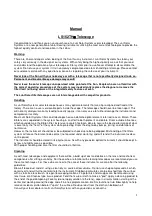
different ways.
1. To move the telescope to an object, simply
move the telescope tube in the horizontal
and/or vertical plane until it is centered in
the red dot viewfinder. The object will now
be in the eyepiece of the telescope.
2. Once an object is found, you can then use
the slow motion controls [5,12] to make
smooth and precise movements as you
follow (or “track”) an object as it moves in
the eyepiece.
You will enjoy your telescope even more as
you learn more about it. But don’t be scared
off by difficult terms or complicated
procedures. Don’t panic! Just relax and enjoy
your scope.
THE MOST IMPORTANT RULE
We have one very important rule that
you should always follow when using
your telescope:
Have Fun!
Have a good time when you’re observing. You
may not know everything that there is to
know about a telescope or what all the sights
in the universe are, but that’s OK. Just point
and observe at first.
You will begin to grow and learn more about
astronomy the more you observe. Go to the
library and read some books about the stars
and planets. Read about astronomers of
old. Many of them had telescope no bigger
than the one you are using right now.
Galileo, who is one of the first astronomers
to use a telescope, discovered four of the
moons of Jupiter with a telescope about the
same size as yours (and his didn’t even
focus very well!).
OBSERVING
Observe during the daytime: Try out
your telescope during the daytime at
first. It is easier to learn how it operates and
how to observe when it is light.
Pick out an easy object to observe: A distant
mountain, a large tree, a lighthouse or
skyscraper make excellent targets. Point the
optical tube so it lines up with your object.
Use the red dot viewfinder: If you have not
done so, align the viewfinder (2) with the
telescope’s eyepiece (1) as described earlier.
Look through the viewfinder until you can
see the object. It will be easier to locate an
THE MEADE 4M COMMUNITY
You haven’t just bought a telescope, you have embarked
on an astronomy adventure that never ends. Share the
journey with others by accepting your free membership
in the 4M community of astronomers.
Go to www.Meade4M.org to activate your membership
today.
5
S
SU
UN
N W
WA
AR
RN
NIIN
NG
G
NEVER USE YOUR TELESCOPE
TO LOOK AT THE SUN!
LOOKING AT OR NEAR THE SUN WILL CAUSE
INSTANT AND IRREVERSIBLE DAMAGE TO YOUR
EYE. EYE DAMAGE IS OFTEN PAINLESS, SO THERE
IS NO WARNING TO THE OBSERVER THAT DAMAGE
HAS OCCURRED UNTIL IT IS TOO LATE. DO NOT
POINT THE TELESCOPE OR ITS VIEWFINDER AT OR
NEAR THE SUN. DO NOT LOOK THROUGH THE
TELESCOPE OR ITS VIEWFINDER AS IT IS MOVING.
CHILDREN SHOULD ALWAYS HAVE ADULT
SUPERVISION WHILE OBSERVING.
Looking at or near the
Sun
will cause
irreversible
damage to your eye. Do not point this telescope at or near the Sun. Do not look through the telescope as it is moving.
NG-70SM_Manual_2008.qxd 3/20/09 4:19 PM Page 7
Summary of Contents for NG70-SM
Page 1: ...MANUAL racting Telescope NG 70SM 18 PM Page 1...
Page 18: ...ENT GOOD POOR DRAWING OF IMAGE RVATION LOG 19 PM Page 18...
Page 19: ...NT GOOD POOR DRAWING OF IMAGE RVATION LOG 19 PM Page 19...
Page 20: ...NT GOOD POOR DRAWING OF IMAGE RVATION LOG 19 PM Page 20...
Page 21: ...NT GOOD POOR DRAWING OF IMAGE RVATION LOG 19 PM Page 21...
Page 22: ...NT GOOD POOR DRAWING OF IMAGE RVATION LOG 19 PM Page 22...
Page 23: ...19 PM Page 23...



































